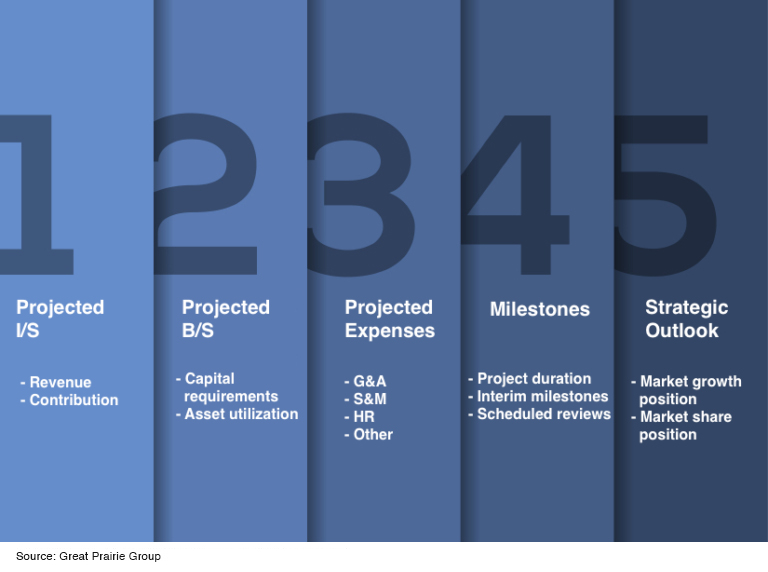A key moment of truth between the company board and its executive leadership is the Performance Commitment – an agreement that represents the actions that will be taken, the financial implications, and the strategic outcome to be expected. When it comes to strategy execution, a Performance Commitment is essentially a promise that the executive team makes to the board. During the strategic planning process and at the time of resource allocation, the executive team spells out the strategic initiatives that it will carry out to execute the business strategy, and commits to deliver the expected financial results – all in exchange for funding. Invariably, three questions come up: What does a Performance Commitment accomplish? What does it include? What are the benefits?
WHAT DOES A PERFORMANCE COMMITMENT ACCOMPLISH?
The Performance Commitment defines the strategic initiatives and the financial consequences, as measured by revenues, costs, margins, asset utilization and investments. In so doing, a performance commitment provides several important advantages:
- Aligns personal and strategic goals
- Builds trust and understanding
- Enhances communication and feedback
- Ensures that agreed-upon targets are relevant and achievable
- Provides fair and objective terms to evaluate performance
- Maintains team members accountable for their performance
- Makes performance a shared responsibility among team members
The challenge is how to execute an agreement that keeps the execution team moving in the right strategic direction, yet flexible enough to allow the leadership team enough latitude to make mid-course strategic corrections as needed.
WHAT DOES IT INCLUDE?
A Performance Commitment spells out the financial plan supporting the strategic initiatives and the expected strategic outcome. The financial plan includes income statement components as well as capital and asset requirements of the business. It also includes the projection of the expenses required to bring the initiative(s) to fruition. Each of these components builds on the conclusions of previous parts of the strategic planning process: getting the critical success factors right and harnessing the power of the few key strategic initiatives.
The Performance Commitment of Strategic Planning

- Projected Income Statement: detailed financial projections to include a three-year forecast of revenue and contribution corresponding to the strategy and the supporting strategic initiative(s).
- Projected Balance Sheet: detailed financial projections of the capital and asset requirements for the next three years based on the strategic initiative(s).
- Projected Expenses: detailed projections of required expenses for the next three years, including G&A. S&M, HR, and other expenses.
- Milestones: a schedule of project duration, calendar, built-in milestones, scheduled progress reviews, and expected results at checkpoints along the way.
- Strategic Outlook: a clear statement of the strategic outcome expected in three years, including market growth position and market share position.
The analysis should be performed at the level of the strategic initiative or set of strategic initiatives for the division. The analysis is then combined with the analyses of other divisions and consolidated at the business level for the overall strategic business plan.
WHAT ARE THE BENEFITS?
The biggest benefits of a Performance Commitment are accountability and open dialogue. Furthermore, because the commitment works off a shared understanding of the strategy, the supporting strategic initiatives, and the underlying assumptions, if conditions change along the way, plans can be revisited and revised.
Accountability. What is particularly important for the execution team is the freedom to execute and to exercise value judgment within the confines of the strategic plan, including timing and focus. However, with such freedom also comes responsibility for actions and results.
Recovery. In case unexpected setbacks prevail, or the execution team fails to meet some milestones, with a Performance Commitment in place, the leadership team can intervene effectively. It can retrace the steps and the underlying assumptions, compare actual vs. planned results, get to the source of the deviation, and take swift corrective action.
Lower Risk. Not only do periodic checks lower the risk of failure, but they also keep everyone closely aligned to the attainment of short-term target results – thereby increasing the likelihood of success.
In our experience, companies that execute strategy well take the opportunity to lock in a Performance Commitment during the last stage of the strategic planning process. Prior to resource allocation, the leadership of the company and the executive team naturally come together, and can forge a valuable partnership in pursuing joint objectives. For all these reasons, a well-crafted Performance Commitment goes a long way to increasing the odds of success in executing a company’s business strategy.

